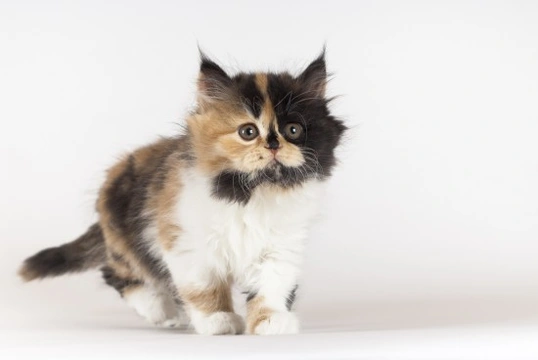
Common cat coat patterns explained
While most of us are familiar with standard cat descriptives such as tabby, black and white or spotted, many of us fall down when things get more complicated! If somebody is trying to explain to you the pattern of a cat’s coat or if you are trying to describe a cat to them, it can be helpful to ensure that you are both on the same page and in agreement about your terminology! Whether you just want to check if you understand exactly what is what or if you find some of the terms used to describe cats (such as mackerel pattern, or self coloured) confusing, read on for our handy at-a-glance guide to common cat coat pattern terminology.
Tabby types
One of the most common and popular cat coat colours is tabby, and most of us would be able to pick a tabby cat out of a line up! Tabby cats have a distinctive spotted, dotted, striped or otherwise recurring pattern, and can appear in many different colours (which is why you may hear terms like ginger tabby or black tabby). But there are various different pattern variations even within the term tabby itself, which consist of:
- The mackerel tabby is the most common tabby colour, consisting of vertical curved stripes on the body and bars of colour on the legs, tail and cheeks.
- The classic tabby has a swirled or whirled pattern on the coat, and a lighter pattern on the shoulders. Rings and bars are again present on the legs, tail and face.
- The spotted tabby is similar in appearance to the mackerel tabby, but the bars and stripes are further broken up into more of a spotted pattern. How distinctive this is will vary from case to case. The Bengal cat can be described as a spotted tabby.
- The ticked tabby has agouti hairs, or hairs that have a contrasting band of colour around them, producing the pattern. This is distinctive to the other tabby patterns, which are produced due to the mixture of contrasting hairs that are individually all one colour. Ticking gives a flecked or salt and pepper appearance to the coat, and again, may come accompanied by stripes or bars on the tail, face and legs.
Ginger
Ginger is a colour descriptive for cats, which is often accompanied by a tabby pattern within the coat, but can also appear as a solid colour or with patches of white. Many people assume that ginger cats are always male, but this is not the case! In some countries, ginger cats are referred to as blonde. The Turkish Van cat’s most common colour is a blend of ginger and white.
Tortie or tortoiseshell
Tortie cats, however, are sex-specific, and almost without exception female. Male tortie cats are very rare, and usually born sterile. The tortie or tortoiseshell coat pattern consists of a brindle or mottled mixture containing three or more colours across the body, commonly ginger, white and black or ginger, white and blue. The tortie classification usually has black or a darker colour as the main colour; cats with a colour mixture that is heavier on the white tend to be classed as calico cats. The actual pattern distribution can vary from solid and clear blocks of each colour, to an evenly blended distribution of the component colours. Torties may also have white areas as well as the white that is incorporated within the tortie pattern, such as across the legs or tummy. Tortoiseshell is one of the most desirable coat colour patterns for the Japanese Bobtail breed.
Calico
Calico cats are often referred to as tortoiseshells, and in some areas the term tortie will be used to encompass calico cats as well. But the calico cat, while very similar to the tortie in terms of colour makeup and distribution, will be predominantly white or light coloured in terms of the make up of the colour pattern, rather than black or dark coloured.
Self coloured
A cat that is “self coloured” is simply a cat that is the same colour all over uniformly, without any areas of a contrasting colour or obvious pattern. The Russian Blue cat is a good example of this.
Ticked
A ticked coat refers to a coat containing agouti hairs, hairs that are not uniformly the same colour along the entire length. A ticked coat gives a flecked or graduated effect, and is the type of coat pattern that is one of the more popular variations of the Australian Mist cat coat.
Points
“Points” on a cat refer to the extremities, which can appear in a contrasting colour to the rest of the body. The points of the cat are considered to the legs, tail and mask (face) and these points appear in a contrasting colour (and sometimes pattern) such as in the case of the Siamese cat. For many cat breeds including the Siamese, kittens are born in a uniform colour, and their points and eventual colour only develops as they get older!



